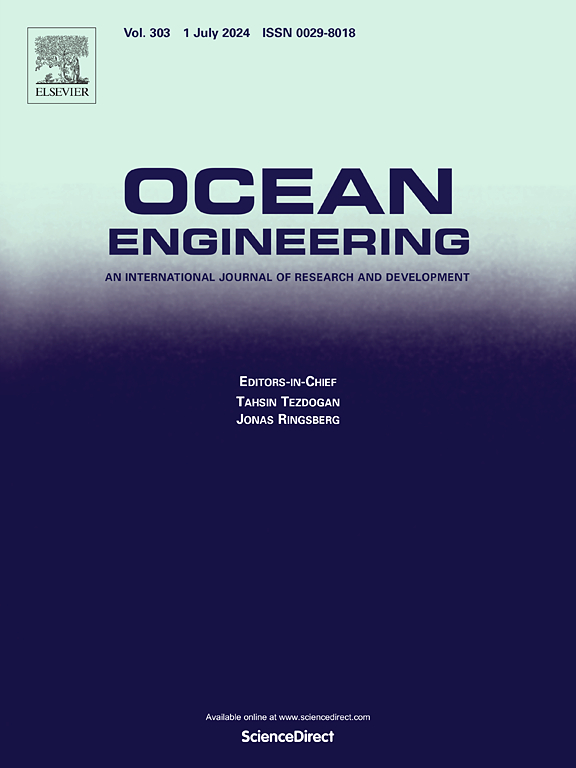Numerical investigation of water wave impacts on partially submerged perforated semi-circular structures
IF 5.5
2区 工程技术
Q1 ENGINEERING, CIVIL
引用次数: 0
Abstract
Wave impacts, prevalent in engineering, pose significant threats to coastal and offshore structures. Investigating their effects on diverse structures offers insights into the underlying mechanisms, which enhances engineering applications. This paper focuses on the overall characteristics of wave slamming on partially submerged perforated semi-circular structures, emphasizing the temporal and spatial characteristics of impact pressure, air entrapment, and the influence of porosity, focusing instead on qualitative insights rather than quantitative analysis of the relationship between wave parameters and loads. A two-phase flow model, incorporating the Volume of Fluid (VOF) method and accounting for air compressibility, was utilized. Structures with different porosity were studied. The incident wave condition was the 2nd-order Stokes wave, with a maximum structural height-to-water depth ratio of 0.529 in front of the structures. Numerical results indicate that pressure distribution on the structures can be categorized into four zones: the impact zone, the quasi-hydrostatic zone, the slightly affected zone, and the strongly fluctuated zone. The maximum pressure occurs in the vicinity of the still water level, and in most cases, this maximum pressure point is slightly below the still water level. The trapped air pocket between the wave surface and the structure can induce pressure oscillations. Conversely, air bubbles entrained in the water and air trapped within the perforated structures exhibit less significant effects. Structures with large openings exhibit a triangular pressure-time curve during a single impact cycle, whereas those with small openings show a more prominent quasi-hydrostatic component.
水波对部分浸没穿孔半圆结构影响的数值研究
波浪冲击在工程中普遍存在,对沿海和近海结构构成重大威胁。研究它们对不同结构的影响可以深入了解潜在的机制,从而增强工程应用。本文重点研究了部分浸没穿孔半圆形结构的波浪撞击的总体特征,强调了冲击压力、空气夹持和孔隙率影响的时空特征,着重于波浪参数与荷载关系的定性认识而非定量分析。采用了考虑空气可压缩性的两相流模型,并结合了流体体积法(VOF)。研究了不同孔隙率的结构。入射波条件为二阶Stokes波,结构前方结构高水深比最大为0.529。数值计算结果表明,结构上的压力分布可分为四个区域:冲击区、准静水区、轻微影响区和强烈波动区。最大压力点出现在静水位附近,在大多数情况下,这个最大压力点略低于静水位。波面与结构之间的气穴会引起压力振荡。相反,气泡夹带在水和空气被困在穿孔结构表现不明显的影响。大开口结构在单次冲击循环中表现出三角形的压力-时间曲线,而小开口结构则表现出更突出的准流体静力成分。
本文章由计算机程序翻译,如有差异,请以英文原文为准。
求助全文
约1分钟内获得全文
求助全文
来源期刊

Ocean Engineering
工程技术-工程:大洋
CiteScore
7.30
自引率
34.00%
发文量
2379
审稿时长
8.1 months
期刊介绍:
Ocean Engineering provides a medium for the publication of original research and development work in the field of ocean engineering. Ocean Engineering seeks papers in the following topics.
 求助内容:
求助内容: 应助结果提醒方式:
应助结果提醒方式:


